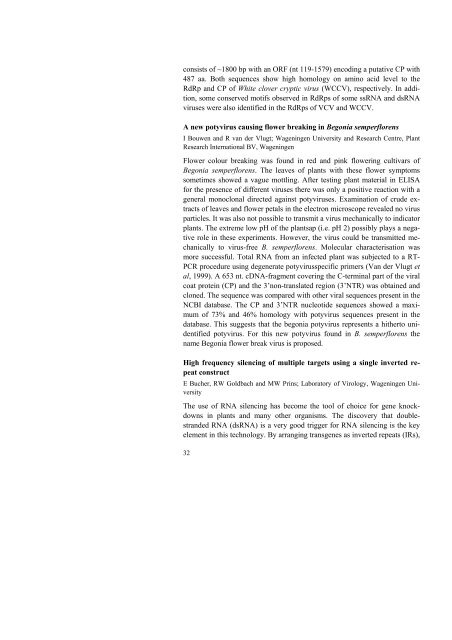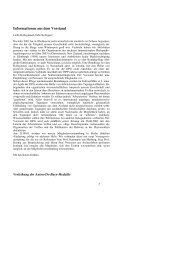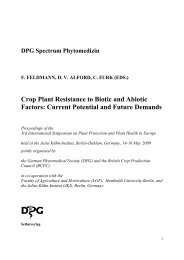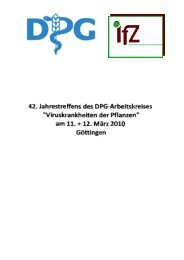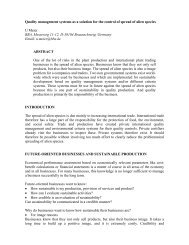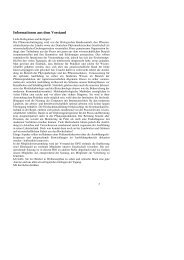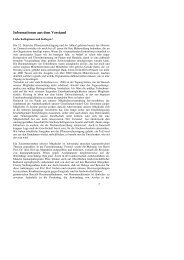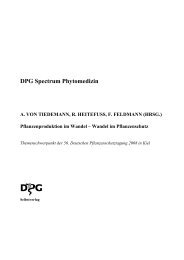PHYTO MEDIZIN Mitteilungen der Deutschen ... - Die DPG
PHYTO MEDIZIN Mitteilungen der Deutschen ... - Die DPG
PHYTO MEDIZIN Mitteilungen der Deutschen ... - Die DPG
Sie wollen auch ein ePaper? Erhöhen Sie die Reichweite Ihrer Titel.
YUMPU macht aus Druck-PDFs automatisch weboptimierte ePaper, die Google liebt.
consists of ~1800 bp with an ORF (nt 119-1579) encoding a putative CP with<br />
487 aa. Both sequences show high homology on amino acid level to the<br />
RdRp and CP of White clover cryptic virus (WCCV), respectively. In addition,<br />
some conserved motifs observed in RdRps of some ssRNA and dsRNA<br />
viruses were also identified in the RdRps of VCV and WCCV.<br />
A new potyvirus causing flower breaking in Begonia semperflorens<br />
I Bouwen and R van <strong>der</strong> Vlugt; Wageningen University and Research Centre, Plant<br />
Research International BV, Wageningen<br />
Flower colour breaking was found in red and pink flowering cultivars of<br />
Begonia semperflorens. The leaves of plants with these flower symptoms<br />
sometimes showed a vague mottling. After testing plant material in ELISA<br />
for the presence of different viruses there was only a positive reaction with a<br />
general monoclonal directed against potyviruses. Examination of crude extracts<br />
of leaves and flower petals in the electron microscope revealed no virus<br />
particles. It was also not possible to transmit a virus mechanically to indicator<br />
plants. The extreme low pH of the plantsap (i.e. pH 2) possibly plays a negative<br />
role in these experiments. However, the virus could be transmitted mechanically<br />
to virus-free B. semperflorens. Molecular characterisation was<br />
more successful. Total RNA from an infected plant was subjected to a RT-<br />
PCR procedure using degenerate potyvirusspecific primers (Van <strong>der</strong> Vlugt et<br />
al, 1999). A 653 nt. cDNA-fragment covering the C-terminal part of the viral<br />
coat protein (CP) and the 3’non-translated region (3’NTR) was obtained and<br />
cloned. The sequence was compared with other viral sequences present in the<br />
NCBI database. The CP and 3’NTR nucleotide sequences showed a maximum<br />
of 73% and 46% homology with potyvirus sequences present in the<br />
database. This suggests that the begonia potyvirus represents a hitherto unidentified<br />
potyvirus. For this new potyvirus found in B. semperflorens the<br />
name Begonia flower break virus is proposed.<br />
High frequency silencing of multiple targets using a single inverted repeat<br />
construct<br />
E Bucher, RW Goldbach and MW Prins; Laboratory of Virology, Wageningen University<br />
The use of RNA silencing has become the tool of choice for gene knockdowns<br />
in plants and many other organisms. The discovery that doublestranded<br />
RNA (dsRNA) is a very good trigger for RNA silencing is the key<br />
element in this technology. By arranging transgenes as inverted repeats (IRs),<br />
32


